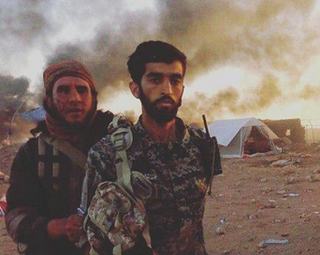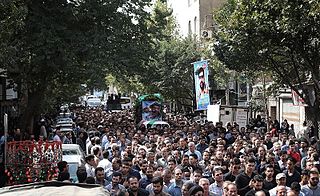Istishhad is the Arabic word for "martyrdom", "death of a martyr", or "heroic death". Martyrs are given the honorific shaheed. The word derives from the root shahida, meaning "to witness". Traditionally martyrdom has an exalted place in Islam. It is widely believed among Muslims that the sins of believers who "die in the way of God" will be forgiven by Allah. Shia views on martyrdom have been profoundly influenced by internal Muslim conflicts, notably Husayn ibn Ali's martyrdom at Karbala in 680, shaping it as a central belief and practice.
The Tyre headquarters bombings were two suicide bombings against the Israel Defense Forces' headquarters building in Tyre, Lebanon, in 1982 and 1983. The blasts killed 104 Israelis and 47–59 Lebanese, wounded 95 people, and were some of the worst losses ever for the IDF. The second attack occurred in November 1983 and was attributed to Hezbollah.

Sayyid Ahmad Kazemi was an Iranian army brigadier general and one of the most notable soldiers in the Iran–Iraq War.

Ahmad Keshvari was an Iranian military helicopter pilot in the Iranian Army Aviation who is known for his prominent role in the early months of the Iran-Iraq War where he stopped Iraqi armored columns from further advancing into western Iran.
Ahmad Motevaselian was an Iranian military officer and attaché who was one of four Iranians who disappeared in Lebanon in 1982. During the Iran–Iraq War, he served as a commander in the Islamic Revolutionary Guard Corps and established the 27th Muhammad Rasulullah Division. He played a role in the Second Battle of Khorramshahr and later, as part of a senior diplomatic group of political and military leaders, went to Syria. On 5 July 1982, when the vehicle carrying the diplomats was passing through a checkpoint post on its way to Beirut, it was intercepted by Phalange Party. The car and four passengers, completely disappeared.

Mir Asadollah Madani Dehkharghani was an Iranian politician and Shia cleric. He was the second Imam Jumu'ah of Tabriz, the Imam Jumu'ah of Hamadan, the representative of the Supreme Leader in East Azerbaijan for less than a year, and a member of the Muslim People's Republic Party. Madani was also Hamadan Province's representative in the first term of the Assembly of Experts.

Ghazanfar Mohammad Asl Roknabadi was an Iranian diplomat, who served as the Iranian ambassador to Lebanon from 2010 to 2014. Rokanabadi is known to have had strong ties to Lebanon's Hezbollah. He survived many assassination attempts during his service in Lebanon.

Mohsen Hojaji was an Iranian military officer. He served as an Islamic Revolutionary Guard Corps (IRGC) adviser to the pro-government forces in Syria during the Syrian Civil War. He was captured by the Islamic State forces near al-Tanf in southeast Syria, and was beheaded two days later. The Islamic State published a video of his capture, a picture of which went viral among Iranians in social media. His captivity and subsequent murder received widespread reaction among the Iranian people, government, and military.

Holy Shrine Defenders, known in Persian as Modāfe'ān-e-Haram, is a phrase used by the Iranian government to refer to their advisers and military personnel, whether Iranians or otherwise, fighting in Iraq and Syria in defense and protection of Shia peoples and holy shrines often targeted by Sunni fighters. The most prominent shrine associated with the mission of the "holy shrine defenders," and to which their presence in Syria is ostensibly dedicated, is the Sayyidah Zaynab Mosque in Damascus.
Saad Sayel was a Palestinian commander and former Jordanian army officer who served as head of the Fatah security apparatus. and founder of the Yarmouk Brigade. He played a prominent role in rebuilding the PLO's military apparatus and training troops alongside Yasser Arafat, Khalil al-Wazir, Muhammad Youssef al-Najjar and others.
Mohammad Doroudian is an Iranian writer, historian, researcher and theorist. Doroudian was born on 1959 in Tehran, and actively writes about the history of the Iran-Iraq War. He holds a BA in History from Shahid Beheshti University. More than seventeen books have been published by Mohammad Doroudian so far. He is one of the elect of the 31st Iran's Book of the Year Awards and the winner of the 8th Holy Defense Year Book Award.

Abbas Nilforoushan was an Iranian brigadier general of the Islamic Revolutionary Guard Corps (IRGC), who served as Deputy of Operations. He began his military career in 1980 with the Basij, then joined the IRGC and was a member of this organization throughout the Iran–Iraq War.

Hassan Bagheri was an Iranian military officer and journalist, and prominent military figure in the Iran-Iraq War. He served as the deputy commander of the IRGC Ground Forces during the war, and was one of the senior IRGC commanders that played a key role in the liberation of Khorramshahr.

Down with Israel or Death to Israel is a political slogan against Israel, which is also used in Iran and other countries such as Iraq and Mexico. Every year, Iranian pilgrims sing the slogan of "death to Israel" during the Hajj rituals and the ceremony of disavowal of polytheists. This slogan is especially chanted against Israel by demonstrators on Quds Day and is often accompanied by the burning of the Israeli flag. This slogan has also been used in the atmosphere of the Islamic Consultative Assembly of Iran. In the film released from Iran's missile exercise during Mahmoud Ahmadinejad's presidency, the slogan "Death to Israel" was written on ballistic missiles that were fired at replicas. This slogan in Iran does not mean a mere political slogan, but an expression of the vision of the Iranian government towards Israel's current in the region.

The Gaza War (2008–2009) was accompanied by the stance of many countries and organizations in the world. In Iran, the war were accompanied by the reaction of the people and government officials. The most important of these reactions are the Fatwa of Jihad by Ali Khamenei, the Supreme Leader of Iran, and the sit-in and attack on foreign embassies.

"Operation Tyre" was a suicide attack against the Israel Defense Forces (IDF) in the city of Tyre during the 1982 Lebanon War. It was carried out by Ahmad Jafar Qasir, a Lebanese Shia Muslim who drove an explosive-laden Peugeot 504 towards the IDF command centre in the city. As many as 102 people were killed in the attack, while another 55 were wounded and 10 missing. Responsibility for the car bombing, which preceded another one in November 1983, was attributed to the Iran-backed Lebanese militant organization Hezbollah.

Operations attributed to Israel in Iran is a list of subversive operations in Iran that have been attributed to Israel in the public opinion or the speech of Iranian officials. Israel has not officially claimed responsibility for many of these operations. Israeli authorities have always presented themselves in opposition to the Islamic Republic of Iran and their propagated ideas.

Dariush Rezaeinejad was an Iranian electrical engineering PhD student from K. N. Toosi University of Technology, who was killed in front of his home. Iran's Intelligence Minister Heydar Moslehi said he was "not active in nuclear projects and has nothing to do with the nuclear issue." However, the Associated Press news agency, in a report quoting a foreign official and a former UN nuclear inspector, wrote that Rezaeinejad's research was about high-voltage switches, which are considered an important part in the construction of nuclear warheads in atomic weapons.

Majid Jamali Fashi was an Iranian martial artist, the holder of a world bronze medal in kickboxing, and was accused of assassinating Iranian nuclear scientist Massoud Ali-Mohammadi on the orders of Israel. He was executed after the trial.

Israel's political representation in Iran, also referred to as the Embassy of Israel in Tehran, was a large three-story building on Kakh Boulevard in the capital of Iran, that was owned by the Israeli diplomatic mission. This agency was trying to strengthen the relations between Iran and Israel. Embassy of Israel in Tehran, was the diplomatic mission of Israel in Iran when Iran and Israel had diplomatic relations from 1948 to 1979, the year of the Iranian revolution.















